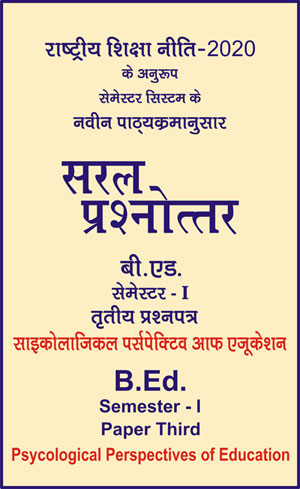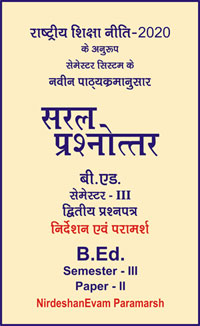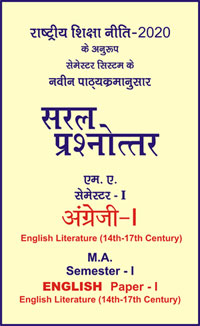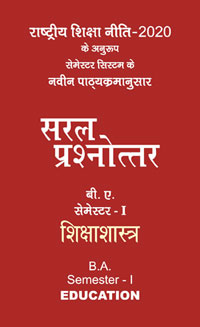|
बी एड - एम एड >> बी.एड. सेमेस्टर-1 प्रश्नपत्र-III - साइकोलाजिकल पर्सपेक्टिव आफ एजूकेशन बी.एड. सेमेस्टर-1 प्रश्नपत्र-III - साइकोलाजिकल पर्सपेक्टिव आफ एजूकेशनसरल प्रश्नोत्तर समूह
|
|
|||||||
बी.एड. सेमेस्टर-1 प्रश्नपत्र-III - साइकोलाजिकल पर्सपेक्टिव आफ एजूकेशन (अंग्रेजी भाषा में)
Question- Explain and evaluate performance Intelligence tests.
Or
How many Types of intelligence ?
Answer-
Performance Intelligence Tests
The performance intelligence test is an example of the non-verbal individual intelligence tests. The word performance is usually applied to tests which require a minimum use of understanding and language. Thus, these tests make us of items requiring “performances” and not language. Hence, these tests can be applied to children, illiterates, feebleminded individuals as well as foreigners.
Pintner-Paterson Performance Scale
An example of the performance intelligence tests is the Pintner-Paterson Performance Scale. It was evolved by Pintner and Paterson in 1617. In this scale there are 15 types of tests, of which 4 are form boards, 6 picture completion, memory span and the rest picture puzzles and imitations etc.
Merrill-Palmer Block Building Test
One of the most important of performance tests for children is Merrill-Palmer Block Building Test. Besides Seguin Form Board it includes block building test as well.
Porteus Maze Test
Another example of the performance intelligence tests is the Porteus Maze test. In it, paper and pencil mazes are used. For his tests, Porteus created mazes for children from 3 to 14 years. It gets difficult, corresponding to the increase in age. The subject is allowed two chances and if he fails in the attempt then the conclusion is that his intelligence is not of that age level. Children of 12 to 14 years are given four opportunities. These tests designed by Porteus not only measure intelligence, but they also reflect the temperament of the individual. It is distinguished from the other tests in as much as that it includes some aspects ignored by such tests as the Stanford Binet tests.
Form Board Test
A comparatively simple example of the performance intelligence tests is the Form board test. Among them the tests of Seguin and Goddard deserve special mention. In the form board test, there are numerous blocks and a board in which there are holes corresponding to this block. The subject has to fit the blocks in these corresponding holes in the board, the time taken and mistakes committed being noted from which the score of the test is calculated.
Wechsler Bellevue Test : Another example of the performance intelligence tests is the Wechsler Bellevue test, evolved in 1939, meant for people from 10 to 60 years of age. In a modern clinic, these tests are included in the Binet class, as one of the most important. In this way, it is the most apt test for measuring the intelligence of adults. In this test there are five verbal tests and five performance tests. This test affords not only an index to mental abilities but also a profile of abilities.
Bhatia’s Battery of Performance Tests : The description of performance intelligence test is incomplete without reference to Bhatia’s Battery of Performance tests. It is the battery created by the former director of Uttar Pradesh Mano-Vigyanshala, Dr. Chandra Mohan Bhatia. It has the following 5 subtests :
(1) Kohez Block Design Test : 10 types of tests out of the Kohez block design tests have been included in the battery. There is one card on every subject upon which is depicted a colour design. The subject or the examinee sees this design and makes a similar one out of the block. These designs become correspondingly more and more complex, having been simple at the start.
(2) Alexander Pass along Test : The Bhatia battery also includes Alexander pass along test, in which too, there are some designs. The subject shifts coloured pieces in an open box and places them in similar design.
(3) Pattern Drawing Test : This test has been developed by Dr. Bhatia himself. In this there are eight cards on each of which there is a particular form. The subject draws a particular figure of pattern after seeing this form.
(4) Immediate Memory Test : Some digits are recited, which are immediately repeated by the subject, throwing this activity some light on the immediate memory of the subject.
(5) Picture Construction Test : In this sub-test there are five subjects, in which pictures relating to the Indian rural life are fragmented into 2, 4, 6, 8, and 12 pieces respectively. At one time, pieces of a picture are placed before the subject who puts them in order and constructs the pictures.
Advantage of Performance Tests :
- As these are generally used for measuring specific abilities, The tests are for some particular categories of persons like deaf, illiterate, language difficulties for vocationally backward etc.
- These are useful for vocational and educational guidance.
- These may be useful for testing neurotics and mentally defective persons.
- These tests are culture free.
Disadvantage :
- These tests do not measure reasoning, judgement and imagination.
- They are costly and difficult to transport.
- They are not able to predict scholastic success in school as well as do the verbal tests.
- As they can hardly be applied twice to the same subjects except after a long interval to without memory on the earlier testing, it is difficult to evaluate their reliability.
Thus, performance tests are essential for measuring general ability, but these can simply supplement verbal tests rather than give independent results.
|
|||||

 i
i 










